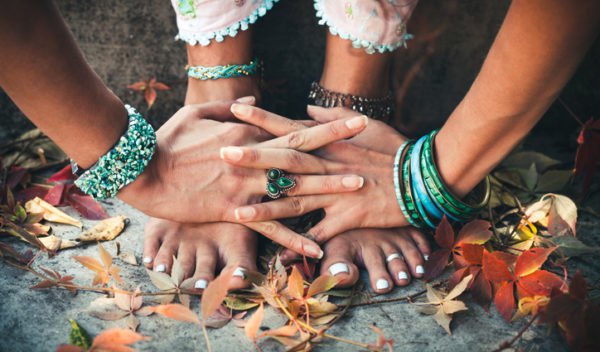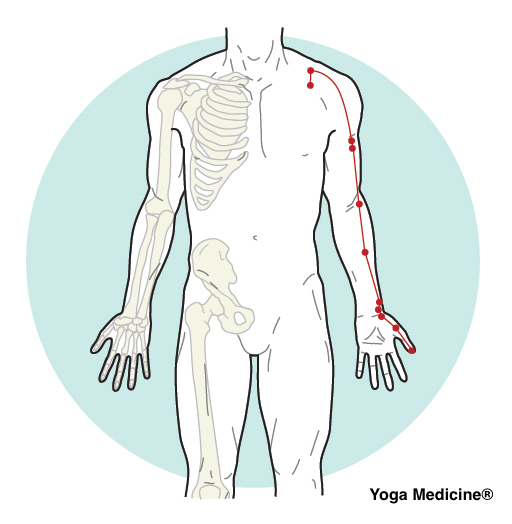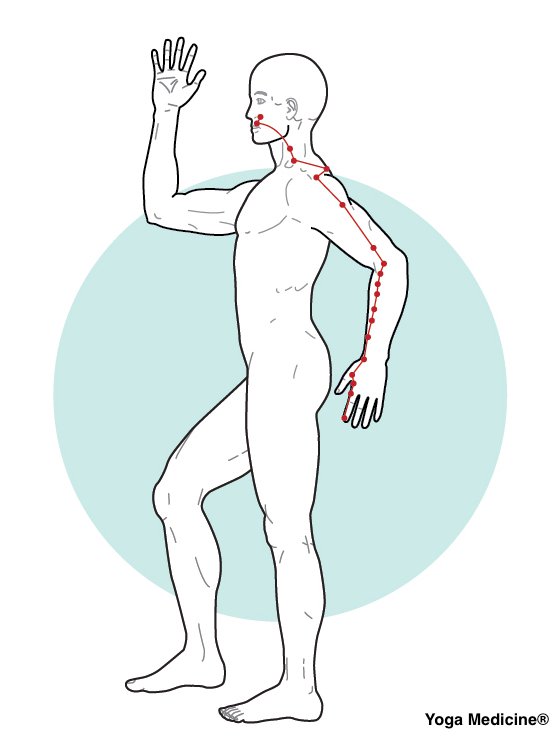Articles, Chinese Medicine, In the Press, Resources, Yin, Restorative and Meditation, Yoga Medicine® News
What Traditional Chinese Medicine says About Fall
for Yoga Medicine® discusses what Traditional Chinese Medicine can tell us about fall, and how we should be treating our bodies this season.

Traditional Chinese Medicine: Fall
For many in the Northern Hemisphere, we have stepped into the threshold of the autumn season. We notice the days getting shorter and feel the nip the air. In time, the trees will dazzle us with their brilliant show of colors before turning in for the sleep of winter. We transition from the easygoing vibe of summer to a more introspective energy of fall.
Organs
In Traditional Chinese Medicine (TCM), every organ in the body is paired with another, and the two complement each other as either yin or yang. Each organ pairing is typically linked to the seasons of the year1, and fall is associated with the Lung (yin) and Large Intestine (yang) meridians in the body. The Lung controls our respiration which also helps regulate the flow of water in our body. The Large Intestine takes care of releasing waste in our bodies.
These organs process what our body no longer needs so that we can only keep what is nourishing and essential. Energetically, the two organs work together so that we can let go and make space for the new. As fall marks the beginning of the yin cycle of the year, we look inward to sift through what we might still be hanging on to in our lives that may have already outlived its purpose. To see if we can soften our grip around these and open ourselves to receive something else.
Elements
Just as the Yin-Yang model symbolizes the creation process through the interaction of bipolar forces, TCM likewise follows the notion of the Five Element Theory.2,3 This theory provides the basis for describing how forms, systems, and events are developed. It postulates that the elements (wood, fire, metal, earth, and water) are the basic elements of the material world. The Five Element Theory is used to interpret the relationship between the physiology and pathology of the human body and the natural environment.4
This season is governed by the Metal element with its qualities of precision, organization, setting limits, and protecting boundaries. From the more carefree days of summer, our days in autumn become more structured as we form routines that take us through our day. Priorities and goals are often reoriented as we prepare for the colder months ahead.
While the best way to stimulate specific Lung and Large Intestine meridian points is through acupuncture, yoga poses can be an efficient way to self-stimulate the meridians.
Fall Meridians: Lung and Large Intestine


The Lung meridian starts in the pectorals and crosses the front surface of the shoulder. From here, it runs along the radial or thumb side of the anterior arm from shoulder to wrist. It crosses the wrist and ends at the corner of the thumbnail.
The Large Intestine meridian begins on the index finger and runs through the webbing between the thumb and index finger. The meridian continues up the thumb side of the posterior arm from wrist to shoulder like a mirror image of the lung meridian on the front of the arm. It then zigzags over the outside top of the shoulder and along the back of the shoulder blades then up through the neck, cheek, lower gums, and teeth.
TCM and Yin Yoga
Practicing yin yoga is an effective way to stimulate the meridians since we hold the poses a little longer than those we do in a vinyasa or flow practice. Props like blocks, blankets, and bolsters are often used as support to allow the student to release and work a little deeper. While you are in a yin pose, expect to let go of muscular effort in order to target this more energetic layer. This translates to working within 50 to 70 percent of your full capacity for stretch.
Below are a few poses that I practice to help my mind and body transition into autumn:
TWISTING CHILD’S POSE
- As you sit in child’s pose, slide your left arm under your chest and towards the right side of your body.
- Let the back of the your left shoulder and side of your face to rest comfortably on the mat. A folded blanket or block can also help support the your shoulder and head here.
- Your right arm can gently stretch overhead towards the top of your mat. Alternatively, it can also just easily rest by your side.
- Hold this pose between 3-5 minutes.
- You may do some languid rounds cat and cow poses before switching sides.
- After both sides are done, rest in child’s pose for one minute.
PUPPY POSE (ANAHATASANA)
- Starting from hands and knees, slowly walk arms towards the front of the mat.
- Gently lower chest towards the ground. A block, stack of blankets, or a bolster for your chest to rest on will provide more support for the upper body. In this sequence, the focus is more on engaging your arms rather than the chest opening that this pose offers.
- As your chest softens towards the floor, press your palms firmly on the mat so that you feel your arms activate. Alternatively, you can press your palms together and bend your elbow to lift hand towards the ceiling, and perhaps, all the way to your upper back.
- Hold for 3 – 5 minutes. Hold the pose for less time if you’re able to bring chest (and chin) on floor watching for sensations on your neck.
- Carefully ease out of the pose by sliding palms to under your shoulders and pressing back up to hands and knees.
- Hold Child’s Pose for a minute as a counter pose.
PRONE SHOULDERS
- Lying prone on the mat, cross your arms in front of your chest. Your arms should be in line with your shoulders. Palms are turned up.
- You may support yourself by having a rolled blanket under your ribs and a block or another rolled blanket for your forehead to rest on.
- Stay for 1-3 minutes and then switch sides.
PEC STRETCH WHILE PRONE ON THE FLOOR
- Lying prone on the mat, spread arms by your side out to a “T” with elbows lining up with shoulders. Palms are turned down.
- Place left cheek on the ground and slide right hand under your shoulder.
- Keeping your left arm and left side chest heavy, use your right hand to help open your chest to the right side of the mat.
- Head can drop down towards the floor or rest on a block or rolled blanket.
- Hips can stack and face towards side right side of the mat.
- Feel the stretch along your left side chest, especially beneath your collar bones.
SPHINX POSE or SEAL POSE
- Start by lying down on your belly.
- With your elbows on the floor and under your shoulders, lift your chest off the floor. Palms are flat on the floor and line up with elbows. They can angle slightly away from each other.
- You can rest your front ribs on a rolled blanket or bolster to help prop your upper body off the ground.
- As you press your palms on the floor, explore putting light pressure on the thumb mound of your palms and through the inside (radial) edge of your arms.
- Without moving your arms, feel like drawing your elbows to your ribs and let your collar bones broaden.
- Keep hips and legs heavy on the mat.
- Hold for 3-5 minutes.
- Child’s pose can be used as counter pose, or simply lie on your belly (removing any added padding) with your cheek on the floor.
If working on Seal Pose:
- Set up similar to Sphinx.
- Walk your palms out to the front of your mat and straighten your arms. Arms can go slightly wider than your shoulders.
- Once again, explore bringing light pressure the the thumb mounds on your palms.
- Keep chest broad and lifted.
- Hold for 1-3 minutes.
- Child’s pose can be used as counter pose, or simply lie on your belly (removing any added padding) with cheek on the floor.
SUPTA BADDHA KONASANA (with Cactus Arms)
- Lie on your back.
- With feet close together, let your bent knees gently splay away from the center of your body. You can slide a block or blanket under each leg for support.
- Bend your elbows by your shoulders and allow arms to rest on the ground. If chest is tight and arms aren’t resting comfortably on the ground, you can prop your arms with blankets under each arm.
- Hold for 3-5 minutes.
SAVASANA
- Lie on your back. You may place a thinly rolled blanket under your knees if your low back feels uncomfortable.
- Let your legs straighten comfortably, close to the sides of your body.
- Let your entire body soften and release.
- Hold for 7-10 minutes.
Footnotes and References:
- Summer, however, is further subclassified as “summer” and “late summer.” Moreover, summer has two sets of paired organs associated with this season: Heart (yin), Small Intestine (yang), Pericardium (yin) and Triple Burner (yang). Late Summer is associated with the Spleen (yin) and Stomach (yang).
- In Traditional Chinese Medicine, this is also referred to as the Five Phase Theory.
- Beinfield, L.Ac., Harriet and Korngold, L.Ac., O.M.D., Efrem. Between Heaven and Earth, A Guide to Chinese Medicine. New York City: Ballantine Books, 1991.
- Cheng, PhD DPA FRSA FRSPH, Raymond. “The Five Elements Theory.” Traditional Chinese Medicine Basics TCM Basics. www.tcmbasics.com. 03 October 2018.












